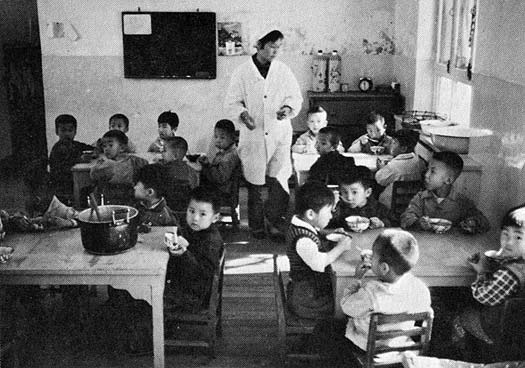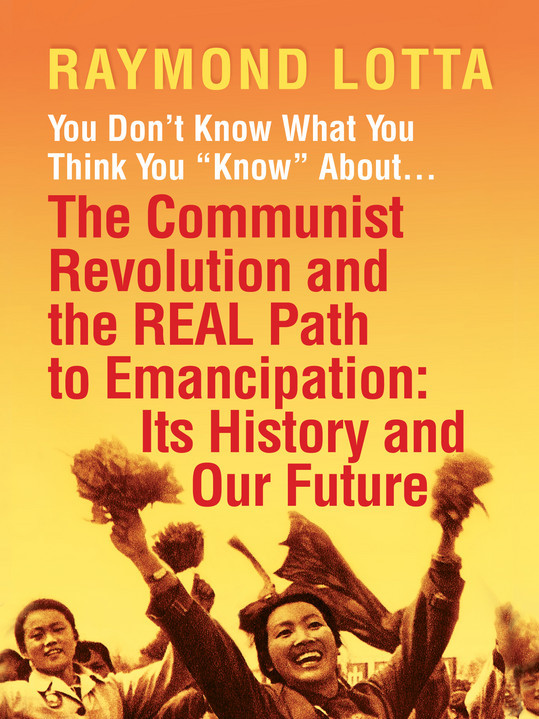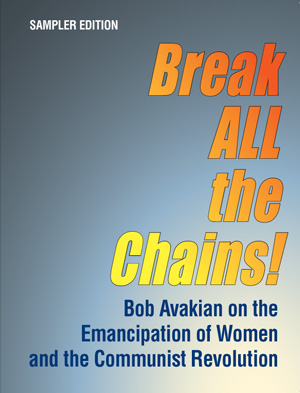When Revolution has its day, people see things a different way
How Collective Childcare Liberated Women in Maoist China
by Li Onesto
| revcom.us
Editors’ note: Bob Avakian has pointed out that “In the context of this current [coronavirus] crisis, the exploitative and oppressive relations built into this system are asserting themselves in a pronounced way, within this country and internationally, just as they have in previous crises....” This is definitely true with the oppression of women, particularly with regard to childcare. With the COVID crisis, women—many who provided the main or sole support for their families—have been disproportionately driven out of the workforce. For example, many hotels and K-12 schools—which employ a high percentage of women—have been closed. And with schools closed, many women have been forced to quit their jobs to take care of their kids. But things do not have to be this way! The following article, first published in 1998, provides a vibrant view of what was achieved in socialist China—what is possible in a society that’s been freed from the shackles of capitalism. Since this article was written, Bob Avakian (BA) has led in forging a qualitatively deeper understanding of the importance and scope of the struggle against women’s oppression in the communist revolution to emancipate all of humanity. The masses of people were brutally oppressed before the Chinese revolution in 1949, and under socialism great strides were made in revolutionizing all of society. (Capitalism was restored in China through a counter-revolutionary coup in 1976.) To get a deeper understanding of this, read BA’s interview with Michael Slate and the interview with Raymond Lotta, “You Don’t Know What You Think You ‘Know’ About... The Communist Revolution and the REAL Path to Human Emancipation: Its History and Our Future.
When women get together and discuss their problems, there’s always a lot of talk about housework and childcare. The ways things are divided up in society, women do most of the housework and have the main responsibility for taking care of children. And as many working women feel in their tired bones, this amounts to “TWO JOBS”—working all day, then coming home to kids and household chores.
This division of labor in society oppresses women. It keeps many women isolated in the home where housework and childcare numb the mind and exhaust the body. And it puts a lot of restrictions on what women can do with their lives and how much they can participate in the revolutionary struggle. A woman who has to spend a large part of her life raising and taking care of children isn’t free to fully contribute to society. And until this oppressive division of labor is gotten rid of, women cannot be liberated.
The question of “who takes care of the kids” is a big issue between men and women. A lot of women end up waging an endless struggle with men to do more housework and childcare. And women all over the world are trying to figure a way out of this situation. Poor women find the cost of childcare doesn’t even make it worth taking a minimum wage job—if there’s one to be found. And many young women have to rely on their mothers to take care of their kids. Middle-class women hire nannies who are frequently immigrants, forced to work for low pay and no benefits. And more and more, we hear that a woman, even if she has important work, must “be a mother first.” This whole situation is really crazy. And this oppressive division of labor between men and women is a world-historic problem. In capitalist society, family life is privatized. Millions of women, in millions of individual homes, go home every night and face the same repetitive jobs of shopping, cooking, cleaning, doing laundry, and putting children to bed. Millions of women are tired out as energy and hours are wasted doing tasks alone that could be organized in a collective, socialized way.
This is a major drain of human resources. And for the proletariat, this is a big problem all around the world. Because as long as this situation exists, half of humanity cannot contribute fully to the development of society. This is why we say, “Unleash the fury of women as a mighty force for revolution.”
All this should make us wonder: Isn’t there a way to organize all of society differently in order to deal with this problem? Yes, there is! In revolutionary China, Mao Tsetung led the people to form a Red Army, seize power in 1949, and go on to build a new socialist society for over 25 years. Mao understood that the revolution must free women from the daily tasks of housework and childcare. Otherwise, half of society would be prevented from playing a full and equal role in building a new socialist society, toward a communist society free of all oppression. And it was with this Maoist point of view that the masses of people in China found a REAL solution to the problem of childcare.
Today, the U.S. rulers tell people “to get back to traditional family values.” But in revolutionary China, the women had to go up AGAINST all the “traditional family values” that had kept women down for thousands of years. This story of how Mao’s revolutionary China solved the problem of childcare is very relevant for all those who, today, are struggling to bring about radical and revolutionary change. For it shows how, when the people get rid of the present system and seize real political power, they can solve problems that can never be solved under capitalism.
And it shows how only communist revolution can liberate women.
*****
In Old China, the ancient philosophy of Confucius governed people’s lives and tradition was a big part of how women were oppressed. Women were considered inferior to men in every way. And a woman’s only role was to serve her husband and give him many sons.
From the very beginning, Mao made the liberation of women an integral part of the revolution. In areas liberated by the Red Army before 1949 there was a lot of struggle against all the feudal traditions which kept women down. And many women from the countryside and the cities joined the ranks of the revolution.
After 1949, laws were passed giving women equal rights to own land, work, and participate in the governing of society. But backward, anti-women thinking existed throughout Chinese society. And bringing women forward to play a full and equal role in building socialism didn’t happen easily, or all at once.
The Communist Party stressed the importance of women “getting out of the home” and participating in the economic and political life of the community. But there was a lot of resistance to this—from men as well as other family members, like mothers-in-law who expected their son’s wife to do all the housework and take care of the children. So this was a problem for the revolution right away.
In the countryside, where most of the Chinese people lived, and in the cities, women’s associations were established. And these organizations helped women struggle against husbands, fathers, and mothers-in-law who wanted to maintain oppressive family relationships. For instance, when a husband refused to take care of the children and wouldn’t allow his wife to get a job or go to a political meeting, the women’s association would organize a delegation to go over and struggle with him to change his ways. If a woman wanted to go out at night to attend a political meeting, the husband would be asked to watch the children. A woman going to a political meeting AND getting her husband to watch the children was unheard of in Old China. And when men took more responsibility for childcare this was a real advance. But the problem of childcare couldn’t be solved as long as it was just a question of sharing this task between husband and wife. Given the weight of tradition, women were bound to end up doing most of the childcare as long as it remained a private, family-by-family problem. The real solution was for childcare to be taken up by society as a whole. Taking care of children, along with other household duties, which each individual family faced, needed to be socialized.
And this process of socializing all the things women did in the home was an important part of building a new society in which people worked and lived in a cooperative and communal way.
Solving the Childcare Problem in a Collective Way
In the early 1950s a network of childcare facilities in city neighborhoods and rural villages was established. These included “nursing rooms” for infants where mothers could feed and care for their babies during the workday. And it included nurseries and kindergartens for children under seven years old who were not yet in school. These nurseries and kindergartens were run by neighborhood organizations, factories, schools, or peasant cooperatives in the countryside. Schools were set up to train childcare nurses and teachers. And in major cities, the Women’s Federation started a series of short-term classes to train people in collective childcare. In the rural areas childcare facilities were, at first, less widely distributed, and many of them were small and experimental. But with the Great Leap Forward in 1958-59, there was a big change in the situation. The Great Leap Forward was a huge mass movement launched by Mao. It was a big step forward in economic development—especially in the countryside where peasants were mobilized to really develop agriculture and small, local industry. It challenged enslaving tradition and thinking.
And the liberation of women was a central issue in this nationwide campaign. Collective forms of farming were developed in the countryside and communes were established where tens of thousands of peasants lived and worked in common. This put less emphasis on the family unit as the center of people’s lives. And as the economic life of people became more socialized, this laid the basis for other things, like childcare, to be socialized. The establishment of socialized childcare was a brand new thing in China. And the Communist Party had to really rely on the masses of women to start these nurseries and kindergartens. If they didn’t do this, the childcare centers would be set up without taking into account the women’s needs and concerns. The women would be reluctant to leave their children with strangers in an institution that had been created without their participation. And more importantly, the masses of women would not be mobilized to struggle against all the backward ideas and practices that had to be struck down if women were to “get out of the house.” After doing some investigation in a village or neighborhood, Communist Party leaders would call the women together to talk things over and air their problems and worries. Together they would figure out how to set up childcare centers to accommodate the whole community. They would divide up the different tasks to be done and how it would be paid for. And after the center was established, there were regular meetings to discuss problems or worries that the children’s parents or the staff might have. In one village they had a hard time finding people to staff the new nurseries. Most of the women preferred to go out with the men to farm the land. Both men and women tended to look down on the task of childcare.
And older retired women weren’t able to take care of a room full of lively youngsters or babies all by themselves. This village eventually solved this problem by sending young unmarried women to take short training courses in nursing and collective childcare. These women were then put in charge of small childcare centers, where they were assisted by older, retired women. And the older women “spoke bitterness” as part of their job, telling the children stories about how the people were brutally oppressed in the old society. The widespread establishment of socialized childcare helped to free up millions of women so they could participate in building socialism. By 1952, the number of nurseries in factories, mines, government organizations, and schools had expanded to 22 times what they had been in 1949. And throughout the 1950s this trend continued, especially during the Great Leap Forward, as many forms of household labor, like cooking, sewing, and grain grinding, were also socialized. By 1959, it was estimated that in rural areas there were almost five million nurseries and kindergartens, more than 3.5 million public dining rooms and numerous flour mills and sewing centers. In the cities, collective service facilities were organized by neighborhood organizations. And this included “street nurseries” and community dining halls. Some of these were quite large, servicing hundreds of families. But others were more simple and small, serving only a few dozen families. Working mothers and fathers could pick their children up after work and either eat with them at a community kitchen or take them home for a family meal. Some cities set up “meals on wheels” delivery services for people who were sick or had to stay home to take care of sick children. Nurseries set up for women factory workers instituted different systems of childcare. There was half-day, whole-day, 24-hour, and weekly care. The time schedules of these nurseries were fitted in with the factory schedules and they were located as closely as possible to where the women worked.
In socialist China, society put a big priority on the establishment of these childcare centers. And this was reflected in how fast these centers were expanded. For instance, in 1959, in the capital city of Peking, there were about 1,250 street kindergartens and nurseries taking care of about 62,000 children. By 1960, these figures had jumped to 18,000 nurseries and kindergartens taking care of more than 600,000 children!
Alongside this great expansion of collective childcare, people in Peking also set up 12,000 community dining rooms, more than 1,200 service repair shops, and 3,700 service centers, where people could drop off clothes to be mended and washed. Smaller nurseries were also set up where women could leave their children for a few hours to go shopping, see a film, or go to part-time school.
Cultural Revolution Hits Deeper at Tradition’s Chains
In 1966 Mao launched the Great Proletarian Cultural Revolution, which was aimed at overthrowing those leaders right inside the Communist Party who wanted to bring back capitalism. Millions of people throughout society were mobilized to debate and struggle over which way society would go. Would the people keep building socialism and getting rid of all the inequalities and differences of class society? Or would the nightmare of capitalism and its dog-eat-dog, profit-above-everything system be restored? The Cultural Revolution hit at all the backward traditions and practices of class society. And the struggle against women’s oppression was a big part of this “revolution within the revolution.” Those who promoted capitalism in China wanted to stop the revolution halfway. They were against breaking down the traditional family structure and they promoted backward, anti-women ideas. Top “capitalist roaders” inside the Communist Party like Lin Piao tried to popularize things like the Confucius saying, “restrain oneself and restore the rights”—the view that everyone should accept their “place” in a hierarchical society. They promoted the view that women should narrowly concern themselves with family and children. And they criticized childcare centers, saying the children were not well taken care of and that society had to be more economically developed before things like childcare could be collectivized.
These party leaders led and mobilized people in society who promoted backward and traditional anti-women ideas. And they sabotaged efforts to socialize housework and childcare. All this underscores even more what a great accomplishment it was that so much of women’s work in the home was collectivized throughout China. The socialization of housework and childcare in revolutionary China was uneven, especially between the cities and the countryside. By 1971, 90 percent of women in China were working outside the home but the collectivization of childcare lagged behind this. In the cities about 50 percent of children between the ages of one and three went to nurseries, while the other 50 percent were taken care of in the home, mostly by grandparents. And in the countryside, the percentage of children in collective childcare was even lower. But socializing childcare in China was a part of the class struggle and it was a big step in the liberation of women. It took tremendous ideological and political struggle in society to create “new socialist things” like collective childcare. And thousands of years of tradition’s chains were challenged and broken when women in China stepped out of the home and joined the struggle to revolutionize all of society. Under Mao’s leadership, millions of people were consciously working to eliminate all inequalities and forms of oppression. And the socialist “new things” this struggle created, like socialized childcare, were a tremendous accomplishment and historic advance.

The liberation of women was a big part of the socialist revolution in China. Socializing childcare, and combating the barriers to do this, including the thinking of people, was an important part of the struggle against women’s oppression—making it possible for women to become equal and full participants in building socialism.
NEW YEAR’S STATEMENT BY BOB AVAKIAN
A New Year,
The Urgent Need For A Radically New World—
For The Emancipation Of All Humanity
Can This System Do Away With, or Do Without, The Oppression of Women?—A Fundamental Question, A Scientific Approach
An article from
Break ALL the Chains!
Bob Avakian on the Emancipation of Women and the Communist Revolution
Download:
Full Edition | Sampler Edition
Order print copies from:
The Bob Avakian Institute
Get a free email subscription to revcom.us:




